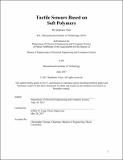Tactile sensors based on soft polymers
Author(s)
Chen, Stephanie, M. Eng. Massachusetts Institute of Technology
DownloadFull printable version (13.42Mb)
Other Contributors
Massachusetts Institute of Technology. Department of Electrical Engineering and Computer Science.
Advisor
Jeffrey H. Lang.
Terms of use
Metadata
Show full item recordAbstract
Piezoresistive carbon black/polydimethysiloxane (CB/PDMS) is a widely used material in the field of artificial skin development because of its high gauge factor to all forms of stress, including tension, compression and shear. While its durability, inexpensive-ness and customizability make CB/PDMS makes it the quintessential active material for pressure-sensing skin, the material itself has not been well-characterized electrically or mechanically. A series of mechanical tests on 0.625" cubes of CB/PDMS revealed that the material's resistance increases monotonically with strain and that CB/PDMS have similar sensitivities to tension and compression across different CB concentrations. Shear sensitivity, however, was relatively poor and inconsistent between samples. To overcome this lack of sensitivity to shear forces, a hair-inspired "pillar" sensor was designed to detect shear forces. The pillar sensor contains two 2 mm x 2 mm x 28 mm CB/PDMS strain gauges embedded in a 3 mm thick PDMS base, and a silicone pillar that has a 5 mm diameter and 6 mm height. Unlike the CB/PDMS cubes, the pillar sensors were very sensitivity to shear forces and presented resistance changes of up to 10% per 0.5 mm until a deflection angle of 20°. These sensors also have the ability to determine the direction of pillar deflection, exhibiting anisotropic behavior when the sensor is structurally constrained.
Description
Thesis: M. Eng., Massachusetts Institute of Technology, Department of Electrical Engineering and Computer Science, 2017. This electronic version was submitted by the student author. The certified thesis is available in the Institute Archives and Special Collections. Cataloged from student-submitted PDF version of thesis. Includes bibliographical references (pages 67-69).
Date issued
2017Department
Massachusetts Institute of Technology. Department of Electrical Engineering and Computer SciencePublisher
Massachusetts Institute of Technology
Keywords
Electrical Engineering and Computer Science.